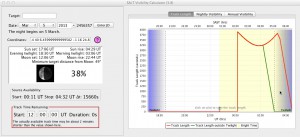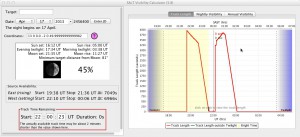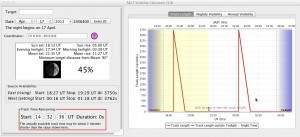SALT Visibility Calculator
You can download the Visibility Calculator from the software page.
Note that the PIPT includes the Visibility Calculator, so that you may check the visibility of a sidereal target from within the PIPT.
Track Times and TTT (too tight tracks) Syndrome
One of the common difficulties encountered by observers is working out how much of my track time can be used for observations? This is particularly the case for equatorial tracks that are often less than an hour long.
The Visibility Calculator can show the Track Length for a given target during the night. If you have targets at different declinations you will notice a big change in the track visibilities shown, for example:
We emphasise that for blocks suffering from TTT (too tight tracks) Syndrome, there is only a very short time window within which the SALT Astronomer can point to the target to obtain the track length required – if miss this window, the block has to wait for the next available window. Add to this some Moon constraints, and it’s easy to see how TTT-blocks can quickly go out of season without being observed/completed. It is important for the PI to ensure the block fits comfortably within the track times.
Checking visibility of multiple targets
The Visibility Tool allows you to output the visibility windows of multiple targets for a whole semester. You can do this by creating a file with your target details in the format used by the PIPT and then using the menu item Targets > Create Multiple Target Visibility Table. Here is what the file might look like:
"NGC 1234" Galaxy 3 9 39.00000000000034 -7 50 43.38999599999895 2000.0 "NGC 123" Unknown 0 27 48.00000000000004 -1 36 3.9968028886505635E-13 2000.0
As the target type isn’t used for the calculation of the visibility windows, you may use Unknown, as shown in the second row of this example.
The visibility windows are output as a csv file (with commas or tabs as separator), which you can use in an application like Excel or Open Office. If you opt to create a single file for multiple targets, a zip file is created.


